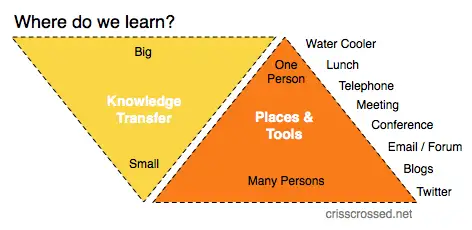Where do we learn - visualizing the limitations of social media
 How and where does most of our learning happens in our daily work life? The visualization above illustrates how intensively the learning process can be, as it can even happen in ordinary places such as the water cooler or the telephone. At our most common daily places and through our daily used tools is where expertise or experiences (tacit knowledge) are exchanged, and so this is also how and where ideas are raised, e.g. during discussions in places such as coffee houses.
How and where does most of our learning happens in our daily work life? The visualization above illustrates how intensively the learning process can be, as it can even happen in ordinary places such as the water cooler or the telephone. At our most common daily places and through our daily used tools is where expertise or experiences (tacit knowledge) are exchanged, and so this is also how and where ideas are raised, e.g. during discussions in places such as coffee houses.
Social media offers some powerful new ways of knowledge sharing, but hence its often asynchronous exchange, it has its limitations with many technical barriers. Everybody using Skype conference calls can tell a story about the technical constraints that this implies. The filter problem is not close to be solved. Services such as paper.li give the impression that we are rather accelerating the information overload.
Social media can reach far more people (e.g. Twitter) and is often the only choice for distance exchange. But can it seriously compensate face-to-face learning? The visualization shall show that knowledge management with social media can support or extend existing practice of sharing. But technology-driven communication has many barriers we need to be aware of. It is these barriers we need to focus on more.